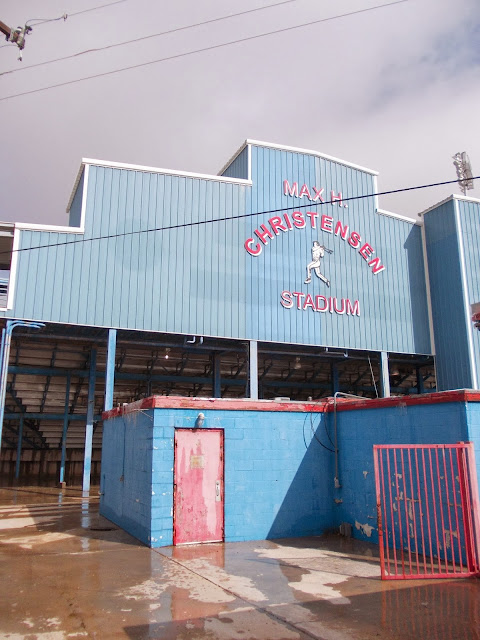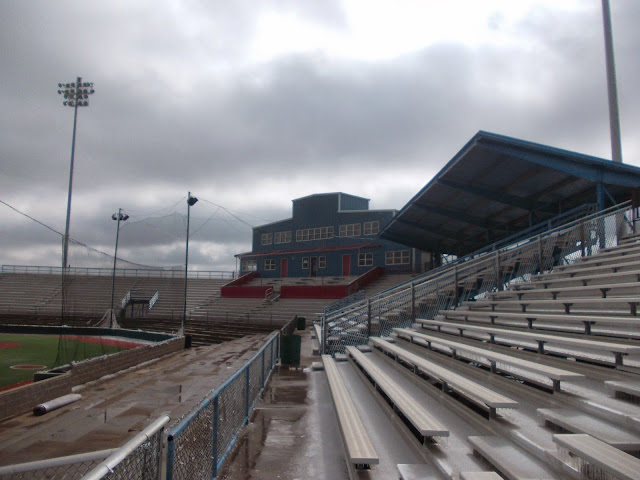WHERE: Alpine, Texas
WHERE EXACTLY: In Kokernot Park, E Hendryx Drive and Fighting Buck Avenue
WHEN VISITED: November 23, 2013 while visiting son Tommy and his art exhibit at Fabrica 309 during Alpine ArtWalk 2013.
WHEN BUILT: 1947.
It was a very cold and icy day when I visited. I had to walk very slowly and gingerly so as not to break my neck.
An interesting little courtyard to the left of the front of the stadium.
The stadium, walls, and several other buildings in the vicinity are built of native stone quarried from the Kokernot Ranch.
Walk-up to the left side ticket window.
Wrought iron metalworks are used thoughout the grounds.
First base side ticket window.
This plaque is mounted to the right of the first base side ticket window.
The stadium was built in 1947 by rancher Herbert Lee Kokernot Jr. for his semi-professional baseball team.
Plaque reads, "KOKERNOT FIELD. DEDICATED TO THE PROMOTION OF A CLEAN AND WHOLESOME SPORT, OUR NATIONAL GAME, BASEBALL."
This plaque is to the right of the main home plate entrance which is now a large roll-up door.
This would be the entrance to the main grandstand.
The team was called the Cowboys and played there from 1947 - 1961.
Making my way around the first base side you notice the use of the glass bricks.
I bet this place was lit up during night games.
Entrance to the first base bleachers.
The field has also been home for the Sol Ross State University Lobos.
Inside this entrance is another ticket window.
The Big Bend Cowboys of the Continental Baseball League played here in 2009-2010.
The place was locked up tight so I had to reach in through the gate to get this shot.
You see the 06 (oh six) logo all over the field. Oh Six was the name of Kokernot's cattle ranch.
Here's a little wider shot.
The stadium was built to seat 1,400 people.
The fields current tenants (along with the Lobos) are the Alpine Cowboys of the Pecos League, an independent professional league.
Now we're working our way around the left side of the stadium.
Not sure what this entrance was used for.
May have been an alternate grandstand entrance.
There are ticket windows just inside of each gate.
This view gives you a good idea of the age of the structure and the use of the glass bricks.
Although now I'm not sure any light would have been generated behind them.
Along the left side of the stadium is this building.
I'm assuming these were offices.
Just to the right of the building is the walkup to the third base bleachers, with another little ticket window inside.
As I was walking around I kicked something and looked down to find this ball half covered in ice.
I knocked off the ice and took it home, a nice keepsake for an awesome weekend.
I think to the interior side of this building (the solid green part) might be the clubhouse for the players.
Modern amenities. This antenna is about the only indication of modernization at this vintage field.
This is the large center field wall.
All the walls were about 10 feet high so it was impossible to get a photo from over the top of them.
And believe me I tried.
This access gate is in the center field wall. It's sunken down about 3 feet to the level of the playing surface.
Not sure what this would have been used for.
Maybe an alternate exit for fans?
There is a "car gate" in the right field corner which was the only way I was able to see inside the stadium.
There was also no way to get my car close enough to the walls so that I could stand on it to peek over the walls, so this shot has to do.
Here's a zoom of that last shot.
I like the way the foul screen just kinda droops down from the grand stand roof.
Lights weren't installed until 1958.
If you're interested in more information, you can read an in-depth Sports Illustrated article on the Kokernot family and this stadium
HERE.

























































